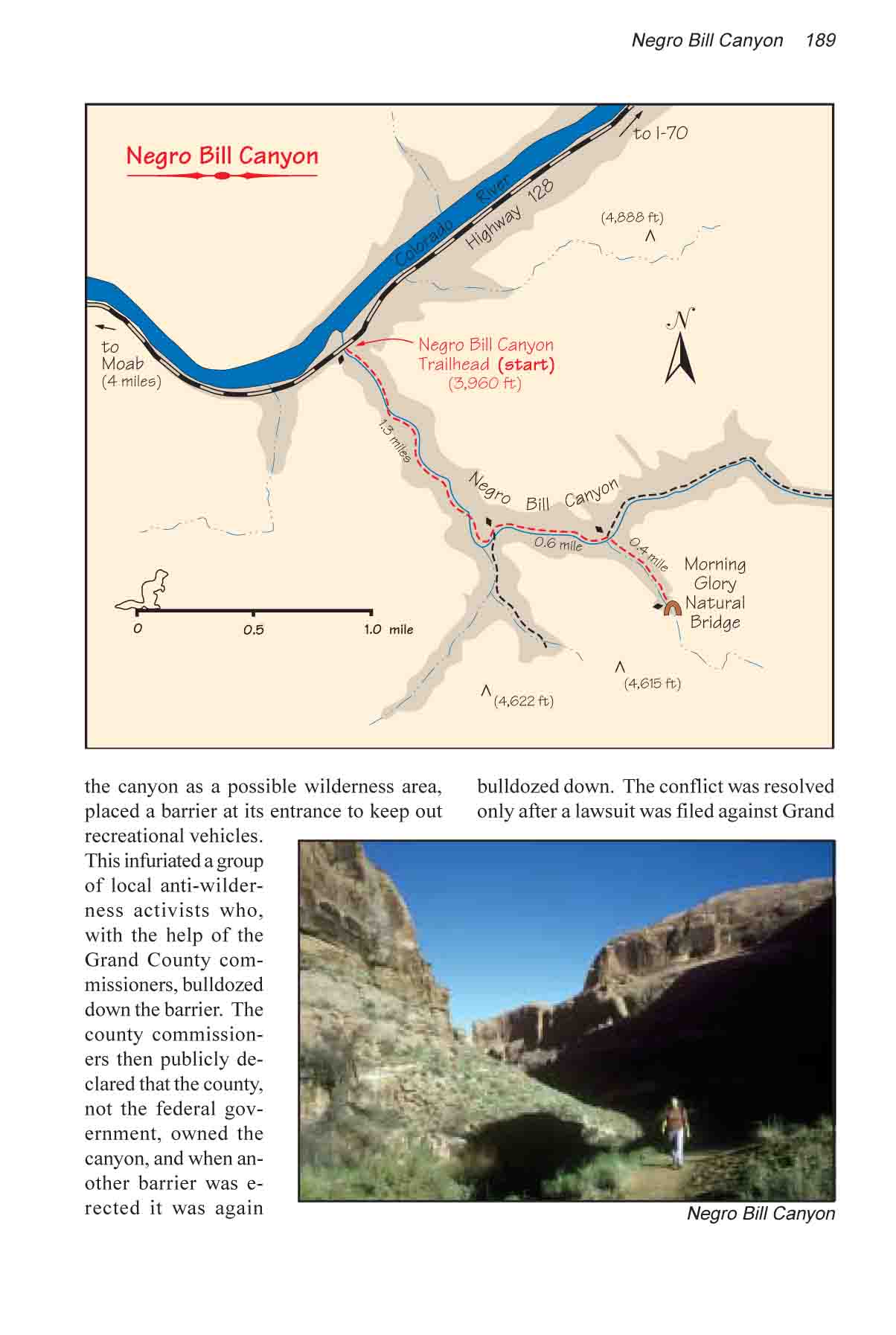|
Links to other sites:
Ordering books & Maps
Comments about this site or our book:

|
Negro Bill Canyon was named
after William Granstaff, a black prospector and rancher who grazed
his cattle here during the late 1800s. It is a lovely canyon,
cut into the Navajo Sandstone by a small, perennial stream that
begins about six miles from the southern shore of the Colorado
River. The trail winds along the stream through an oasis of cottonwood
and willow trees, cut off from the desert above by towering sandstone
cliffs. Like all good hikes, this one also has a reward at the
end. Morning Glory Natural Bridge spans the head of one of Negro
Bill’s side canyons at the end of the trail. According to
Bureau of Land Management statistics, Morning Glory is the sixth
largest natural bridge in the United States. It’s span is
243 feet.
In 1979 Negro Bill Canyon gained
a great deal of notoriety over an action of the so called “Sagebrush
Rebellion”. The Bureau of Land Management, wanting to study
the canyon as a possible wilderness area, placed a barrier at
its entrance to keep out recreational vehicles. This infuriated
a group of local anti-wilderness activists who, with the help
of the Grand County commissioners, bulldozed down the barrier.
The county commissioners then publicly declared that the county,
not the federal government, owned the canyon, and when another
barrier was erected it was again bulldozed down. The conflict
was resolved only after a lawsuit was filed against Grand County
in the U.S. district court.
Today the canyon is still a wilderness
study area, and may soon become the Negro Bill Wilderness Area.
Many residents of Grand County are still against the idea, but
fortunately tempers are no longer as hot as they once were. Four-wheel-drive
vehicles are not now using the canyon and, although there are
still some visible signs of the old jeep roads, most of the mess
has now been cleaned up. With each passing year the old, unsightly
scars are becoming less noticeable.
From the mouth of Negro Bill
Canyon the trail begins by winding its way up the left side of
the stream, then crosses the water four or five times. You may
have to get your feet wet at some of the crossings, especially
during the spring runoff. Wildlife is abundant along the canyon
floor, and you can often see hawks soaring over the pink sandstone
cliffs searching for prey. After 1.2 miles you will see a second
large canyon intersecting Negro Bill on the right. Another less-used
trail heads into this canyon, which you can follow if you feel
like exploring. This is not the canyon containing Morning Glory
Natural Bridge; however it does contain some nice campsites and
picnic spots.
Continuing along the main trail
for another 0.6 mile will bring you to the next major side canyon,
again intersecting Negro Bill Canyon from the right. Here the
path splits again, but this time the main trail turns right,
into the side canyon, and proceeds southward toward Morning Glory
Natural Bridge. The bridge is at the extreme end of the canyon,
0.4 mile from the junction.
Morning Glory Natural Bridge is
unique because it was carved at the base of a waterfall, rather
than across an open stream as most natural bridges are. The space
between the bridge and the cliff over which the water once plunged
is extremely narrow, only about 15 feet wide, but the span of
the bridge is awesome. What a spectacle the waterfall behind
the sandstone bridge must have been when the water was flowing
in full force. Water seldom flows in the dry river bed now, but
there is a small permanent spring near the base of the bridge’s
eastern leg. |

